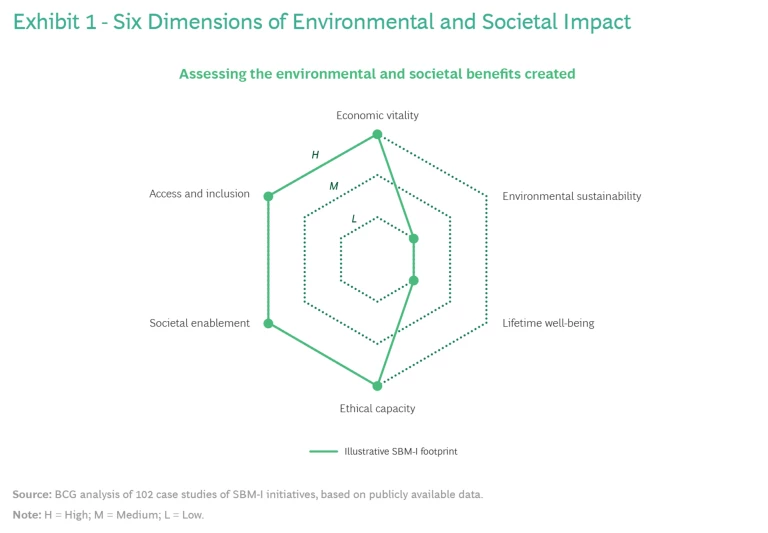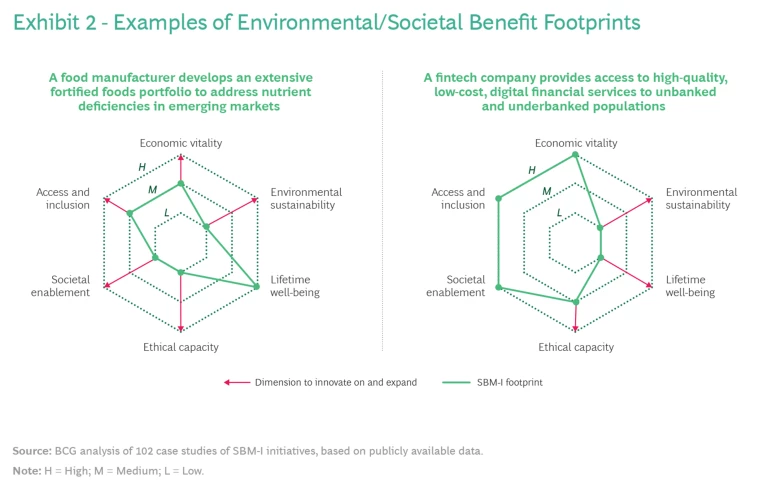This article is part of an ongoing series that describes the concept of “Sustainable Business Model Innovation” (SBM-I) and how companies are putting it to use.
The COVID-19 pandemic has been a singular challenge, testing the resilience and viability of many companies. Undoubtedly, there will be more dramatic challenges and opportunities to manage in the coming decade, including climate change and economic inequality. Fortunately, it is possible for business leaders to contribute to solving environmental and societal challenges through their core business, in ways that also generate new opportunities for business value and competitive advantage. This is the essence of sustainable business model innovation (SBM-I), innovations that deliver returns to shareholders and benefits to stakeholders. As companies now build back in the recovery, how can they assess which business model changes and innovations will also create the most environmental and societal value for their stakeholders?
We believe our insights from researching SBM-I can help answer that question. Crossing all industries and geographies, our research analyzed 102 SBM-I initiatives through which companies delivered both business value and environmental and societal benefits. We evaluated each initiative on the basis of its competitiveness and resilience and then tested it against six dimensions of environmental and societal benefits. (See Exhibit 1.) We believe these six dimensions holistically encompass the range of societal value that a business can generate. In fact, in today’s business context of increasing concerns about environmental and societal issues, a resilient and competitive business model must optimize for both business and social value. Generally, the traditional thinking on business model innovation has not sufficiently or rigorously incorporated how business models create value for stakeholders and the common good.
The Six Dimensions of Business Model Societal Impact
BCG identifies six dimensions of environmental and societal impact, all with implications for employees and for external stakeholders, including investors, customers, suppliers, and society. Below we discuss each dimension and illustrate how it creates environmental and societal benefit, using examples of companies pursuing sustainable business model innovations. In general, the better the business model scores on the six dimensions shown in the spider diagram of Exhibit 1, the more likely the company is well-positioned to deliver benefits to stakeholders and to remain durable under evolving environmental and societal trends, thus contributing to its resilience, sustainability, and competitive advantage over time.
Economic Vitality. A company that scores high on this dimension promotes economic prosperity by creating livelihoods and economic opportunities for employees and workers in its supply chain and in its wider ecosystem. The company also contributes to the economic vitality of communities and society through the way it stimulates economic activity, pays taxes, makes investments, and generates other multiplier effects (such as providing a base for smaller businesses).
Companies supplying digital financial services—such as M-Pesa in Africa, Nubank in Brazil, and Ant Financial in China—help hundreds of millions of unbanked and underbanked customers build financial records, access micro-loans to buy goods and grow their small businesses, and build savings over time or use micro-insurance to protect essential assets or ensure their children’s education. In the course of business, these companies make significant contributions to the economic vitality of society.
Environmental Sustainability. A company that delivers environmental sustainability improves the environmental footprint of its operations, its products and services, and every aspect of its value chain (from sourcing, to use, to disposal). Internally, it develops systems that monitor and reduce its use of energy and materials, decrease its impact on biodiversity and water, lower its greenhouse gas emissions, and eliminate any remaining pollution and waste. Externally, it sets up product take-back and reuse and recycling programs to increase circularity and transform waste into new value streams. Companies at the leading edge of this dimension can solve environmental issues heads-on through business models that create net environmental benefits, beyond just mitigating or reducing negative impacts. For example, they might restore natural habitats, regenerate resources, or provide transportation alternatives with a lower carbon footprint. Much of this is done through innovative use of digital and technological advances.
Interface, the world’s largest manufacturer of modular flooring, now makes carpet tiles from recycled content and bio-based materials. These tiles store carbon, preventing its release into the atmosphere. Combining this technology with end-of-life take-back and recycling programs, Interface has developed the first “carbon negative” flooring products. It is moving closer to its vision of helping to restore the planet, reverse global warming, and leave a positive impact.
Lifetime Well-Being. Here a company generates improvements to the quality of life and well-being of employees, customers, and the wider communities where it operates. It provides employees with healthy, fair, and dignified working conditions, including benefits and opportunities for growth and self-actualization. Its products and services are safe, beneficial, and personally enabling; its community activities foster dignity, safety, health, and education. It thinks about well-being as a design principle in all its business activities, the experience of its customers, and the communication of its brand.
Nippon Insurance, based in Japan, is helping senior citizens live with dignity with a “Gran Age” program that pays out larger annuities to older policyholders. It also provides them with a constellation of complementary services to help prevent cognitive impairment, assist with daily life support, and engage them with social opportunities.
Ethical Capacity. A company that consistently delivers on this dimension strengthens and enforces ethical practices in its own operations and in the wider ecosystem. It establishes robust governance structures, ensures board independence, and practices strong audit and compliance processes. It may put in place responsible sourcing and marketing practices, or systems to ensure data privacy and security. It also builds general trust in business by taking stands against corruption, actualizing human rights commitments (and living up to their ideals), and fostering strong ethical practices in communities and society in general. In this way, it enables transparency and accountability for its own actions and those of its industry.
Lush, a UK-based, privately owned cosmetics company that traversed the billion-dollar sales mark in 2017, has built an iconic brand based on environmental sustainability and ethical values, creating “a cosmetics revolution.” All Lush items are composed of simple, ethically sourced, and vegetarian (80% vegan) ingredients. Lush distinguishes itself from competitors by denouncing animal testing of any sort and committing to engaging only with suppliers who adopt the same ethical stance. Lush applies its values across its own supply chain and operations, while also raising awareness around these issues with consumers, influencing their demand for ethical and sustainable products.
Societal Enablement. A company that fosters societal enablement establishes core activities that promote and contribute to an open, well-functioning organization and society. Internally, this means promoting greater levels of workforce participation, strengthening processes to manage grievances and provide remedies, and increasing data transparency. Externally, this involves developing products and services that enable and support a well-functioning society—a society, for instance, that promotes social participation, ensures secure election and representation processes, supports the effective and efficient delivery of public goods and services, or raises awareness and education on specific issues.
Launched in 2018, Microsoft’s Defending Democracy Program aggregates and expands the company’s cybersecurity offerings to help governments protect election-related campaigns from hacking, defend against disinformation, and preserve the integrity of electoral processes in democratic societies.
Access and Inclusion. A company that makes progress on this dimension ensures that its workers and employees have nondiscriminatory, inclusive, and equitable access to opportunities. These opportunities might include rewards, career options, recognition, and the ability to advance, regardless of social identifiers (for example, ability, age, ethnicity, gender, race, religion, sexual orientation, socio-economic status, or class). Externally, the company designs and makes its products and services available to consumers and communities across the socio-demographic range. It consistently considers how to bring the best of what it does to more and more people.
With its Project Shakti initiative, launched in 2001, Hindustan Unilever has developed a capillary distribution network of more than 100,000 women micro-entrepreneurs. This effort has brought affordable Unilever products to tens of millions of Indian customers living in remote and underserved rural states and villages. The program not only increases access to goods for the customers but also promotes the economic inclusion and empowerment of women.
Companies should assess their business model against the footprint of their total environmental and societal benefits, holistically considering all six of the dimensions. Our own analysis shows that most companies underdevelop their societal benefit (represented by five out of the six dimensions), potentially missing business opportunities that would come from contributing to the common good.
Close to two-thirds of the SBM-I initiatives we studied show a limited footprint across the six dimensions, while only a third create impact on three or more dimensions. Perhaps not surprisingly, the most common dimension of impact found among our sample cases is environmental sustainability (with more than half of cases optimizing for that dimension). Economic vitality ranks second and access and inclusion rank third.
By innovating to expand their scores across all six dimensions, companies can grow their environmental and societal benefit, the basis for new value creation and competitive advantage. They can also future-proof themselves against environmental and societal shocks and shifting trends. For example, a consumer packaged goods company could increase its portfolio of nutritious foods (lifetime well-being) while sourcing closer to its processing centers, thus providing more employment near its customers (economic vitality) and reducing transportation-related emissions (environmental sustainability). Similarly, a fintech that provides microfinance and already facilitates access and inclusion could also mitigate the carbon emissions from its servers or constrain debt-inducing consumption patterns and nudge microloans toward “green” goods and investments, thus boosting ethical capacity and environmental sustainability. Exhibit 2 shows the environmental and societal benefit footprint for two companies seeking to improve their track records.
Resilience Through Sustainability
In the aftermath of the pandemic, as many companies rethink their business models to solve for resilience over efficiency, sustainable business model innovation offers a powerful approach to ensure that business models are robust against future crises. Applying SBM-I requires a frank assessment of the environmental and societal value that your current business model creates for all stakeholders. This assessment should serve as a tool to spur innovation for a more resilient business model. Going forward, a company’s ability to generate broad and demonstrable environmental and societal benefits from its core business model will be a key source of sustainable competitive advantage.








